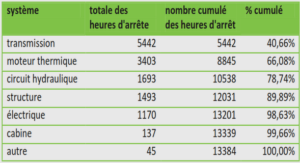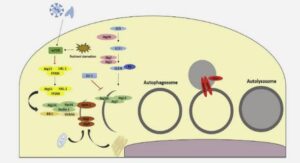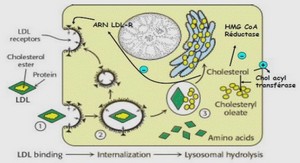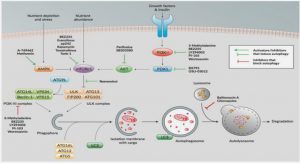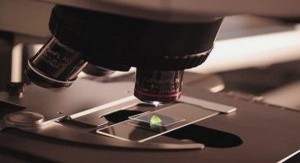Impact des radiations UV-C sur la sensibilité de trois variétés de fraisiers (Fragaria x ananassa) contre Botrytis cinerea
Modèle végétal : le fraisier
Le fraisier appartient à la famille des Rosacées. Fragaria x ananassa est une espèce hybride interspécifique octoploïde à laquelle appartiennent toutes les variétés actuellement cultivées. La création de cet hybride est due à un explorateur français nommé Amédée-François Frézier (1682 – 1773) qui a importé du Chili 5 plantes de F. chiloensis pour sa grande taille des fruits et des plantes de F. virginiana (identifiés en Amérique du Nord). Au début des années 1700, le croisement entre F. virginiana (mâle) avec F. chiloensis (femelle) en France a conduit à la production d’hybrides qui allaient être connus sous le nom d’ananas, progéniteurs du fraisier moderne, Fragaria x ananassa Duch. Les fraisiers sont des plantes vivaces qui se propagent via des stolons (Figure 11). Les feuilles sont trifoliées et se développent à partir de la « couronne » (tige réduite dans le cœur de la plante). Les fleurs sont généralement blanches. Il existe quelques espèces à fleurs roses telles que la variété Toscana.
Les fleurs possèdent 25 à 30 étamines jaunes et 50 à 500 pistils surélevés sur un réceptacle jaune conique. La fleur est habituellement hermaphrodite, et n’a donc pas besoin de pollinisation croisée. Figure 11 : Le fraisier. Le fraisier fait partie de la famille de Rosacées. A) Mode de reproduction asexué du fraisier (phase végétative) : développement de stolons. B) Phase reproductive du fraisier : apparition des fleurs. C) Fructification du fraisier : développement des fraises avec un différentiel de maturation (images personnelles, Pathologie Végétale, INRA PACA Avignon). Le climat joue un rôle fondamental dans la croissance du fraisier puisque selon la saison, l’état de la plante diffère (Risser et Navatel, 1997). En effet, en été, les plants ont plutôt une croissance végétative. Lorsque l’automne arrive, les températures diminuent et cela initie la floraison et c’est au printemps que la phase de fructification commence.
Ce premier chapitre de thèse est rédigé sous forme d’articles : le premier de méthodologie (Annexe 1) et le second de résultats. Chapitre I Impact des radiations UV-C sur la sensibilité de trois variétés de fraisiers (Fragaria x ananassa) contre Botrytis cinerea 89 II. Impact of UV-C radiation on the sensitivity of three strawberry plant cultivars (Fragaria x ananassa) against Botrytis cinerea Cette partie est présentée sous la forme d’un article de résultats accepté dans le journal Scientia horticulturae en 2018 (Figure 12). 1. Abstract Several studies suggest that UV-C radiation, known for its disinfecting effect, may also stimulate plant defenses. The objective of this study is to reduce the sensitivity of strawberry plants (Fragaria x ananassa) to Botrytis cinerea by application of non-deleterious doses of highly energetic UV-C light (254 nm) on leaves. Preliminary tests were carried out on strawberry plants: Cirafine, Charlotte and Candiss, to optimize the doses of UV-C to apply on plants and to test the sensitivity of these three cultivars to B. cinerea. The three cultivars showed Figure 12 : Article accepté dans un journal scientifique concernant la préculture. Cet article a été soumis en 2018 dans le journal Scientia Horticulturae different levels of susceptibility to B. cinerea: Cirafine was the most resistant followed by Charlotte and Candiss being the most sensitive.
These observations were supported by histological examination and phenol levels in the leaves that indicated deeper penetration of B. cinerea into Candiss. Nine variations of treatments were applied to the plants, which were composed of varying UV-C doses and differing application frequencies. The treatment of UV-C applied at 0.85 and 1.70 kJ/m², four times every second day (p-value = 0.05), were shown to have a significant increase, around 25 %, in the protection of Candiss against Bc1 strain of B. cinerea. Our observations show that exposing strawberry plants (Candiss) to low repeated doses of UV-C could improve their resistance against gray mold, while avoiding any apparent negative effects to the plants. Keywords: UV-C radiations, strawberry, Botrytis cinerea, plant defense 2. Introduction The cultivated strawberry Fragaria x ananassa is one of the most important fruit crops worldwide. It is ranked first within berry crops with a worldwide fruit yield of 4.1 million tons per year (Flachowsky et al., 2011). Strawberries are produced in more than 70 countries and organic fruit production is becoming increasingly important (Wilbois et al., 2012). Pathogen development on host plants, especially on plants producing edible fruits, has a major impact on agricultural production giving rise at once economical issue and phytosanitary issue. Several diseases can be particularly damaging for strawberry production, and among these, gray mold is a major concern for growers. Gray mold is an airborne disease, caused by the necrotrophic fungus Botrytis cinerea.
The disease is difficult to control because the fungus can infect the plant as well as the fruits (Williamson et al., 2007). B. cinerea can also cause partial or total destruction of the host plant and its products like fruit, in pre- or post-harvest (Gullino, 1992). The most common and effective strategy to control gray mold is Chapitre I Impact des radiations UV-C sur la sensibilité de trois variétés de fraisiers (Fragaria x ananassa) contre Botrytis cinerea 91 the application of fungicides. Unfortunately, the frequent use of fungicides can lead to the development of pathogen resistance (Fillinger and Walker, 2015). In addition, the excessive use of fungicides can have a negative impact on the environment as well as on human health, requiring the development of environmentally-friendly alternatives.
Therefore, there is a growing interest in alternative methods that could enabled the stimulation of plants defense mechanisms, based on the use of biotic or abiotic factors (Conrath, 2009). Unlike chemical products, abiotic mechanisms for pathogen control, such as light radiation, have been sparsely studied. Outside the visible light, infra-red light (IR) or ultraviolet light (UV) have specific properties which are exploited in agricultural sector and food industries. UV light corresponds to electromagnetic irradiations produced by the sun or by an artificial source. Three types of UV irradiations, corresponding to three ranges of wavelength, are distinguished according to their energy and biological activities. UV-A (315–400 nm) that are less energetic represent 95% of UV irradiations that arrive on earth surface, UV-B (280–315) that are moderately energetic are largely stopped by the ozone layer and UV-C (100–280 nm) that are the most energetic but they are integrally absorbed by the ozone layer. Previous studies have shown that light is an important regulator of plantpathogen interactions (Demkura and Ballare, 2012; Jenkins, 2009; Magerøy et al., 2010).
In response to a sudden exposure to high light intensity or to UV light, plants respond by producing reactive oxygen species (ROS) that play a role in plant defenses against pests and diseases. Similarly the rapid accumulation of ROS at the pathogen attack site is toxic to pathogens directly (Lamb and Dixon, 1997) and can trigger signaling pathways that are responsible for the activation of other defense mechanisms (Dat et al., 2000; Grant and Loake, 2000). Part of these resistances can be attributed to changes in plant tissue metabolites induced by UV-B radiations, which include accumulation of protective phenolic compounds and enhancement of jasmonic acid dependent defense responses (Ballare et al., 1996; Demkura et al., 2010; Foggo et al., 2007; Izaguirre et al., 2003, 2007; Kuhlmann and Müller, 2009; Mazza et al., 1999; Rousseaux et al., 1998). Indeed, UV-B radiations stimulates Chapitre I Impact des radiations UV-C sur la sensibilité de trois variétés de fraisiers (Fragaria x ananassa) contre Botrytis cinerea 92 transcription of defense genes, including those encoding for phenylalanine ammonia-lyase (PAL) and chalcone synthase, two key-enzymes controlling the synthesis of defence-related phenolic compounds, as well as pathogenesis-related proteins such as chitinase and β-1,3-glucanase (El Ghaouth et al., 2003; Bonomelli et al., 2004; Borie et al., 2004). There is however a major problem associated with UV-B light: it is generally effective only when delivered over rather extensive periods of time because of its lower photon energy, typically several hours or days. It is often difficult to consider exploiting UV-B light in practical terms. Hence the idea to using UV-C light which is capable to supply large amounts of energy in a very short period of time. The lethal effect of UV-C light has been exploited successfully to control postharvest diseases, thus extending shelf-life of fruits and vegetables (Liu et al., 2011; Maharaj et al., 1999; Mercier et al., 2001; Mercier et al., 1993a; Siddiqui et al., 2011). Previous studies have also defined hormetic doses that can stimulate plant defense without entailing negative side effects on the stored plant organs like fruits (Charles et al., 2008a-d; Charles et al., 2009; Ouhibi et al., 2015a,b; Pataro et al., 2015; Pinheiro et al., 2015; Sari et al., 2016; Mohamed et al., 2017). Numerous studies have tested different UV-C doses in order to find hormetic dose and doses were in the range of 0.125–9 kJ/m² (Pombo et al., 2011; Ouhibi et al., 2015a,b; Vasquez et al., 2017).
Moreover, UV-C radiation stimulates production of pathogenesis-related proteins that play a significant role in plant defense such as chitinase and β-1,3-glucanase in strawberry leaves infected by Colletotrichum acutatum or in fruit infected by B. cinerea (Casado-Díaz et al., 2006; Jin et al., 2017). If a large number of studies have shown that UV-C radiation elicits defense responses in fruits, few studies have worked on treating plants during their growth. Treating Arabidopsis, Pelargonium or Lettuce plants during their growth with UV-C induces reduction of infection by Hyaloperono sporaparasitica and B. cinerea (Kunz et al., 2008; Darras et al., 2015; Vasquez et al., 2017). Xie et al. (2016) have shown that UV-C treatment applied in pre-harvest caused no leaf damage at the cumulative dose of 3.6 kJ/m², and fruits tend to be firmer and in some Chapitre I Impact des radiations UV-C sur la sensibilité de trois variétés de fraisiers (Fragaria x ananassa) contre Botrytis cinerea 93 case redder.
Unfortunately, there is still a lack of literature on crops destined for human consumption (Vasquez et al., 2017). The objective of this study was to research the impact of non-damaging doses of UV-C radiation in strawberry plant on the sensitivity to B. cinerea. It was carried out on three strawberry cultivars (Cirafine, Charlotte and Candiss) and two strain of B. cinerea (Bc1 and Bc21). We proceeded in two steps. First, we tested the basal level of sensitivity of the three strawberry cultivars against B. cinerea by evaluating lesion development of the pathogen (histological experiment) and by measuring phenols content. Secondly, we tested the effect of single and repeated non-deleterious doses of UV-C radiation on lesion development of B. cinerea on leaves.

